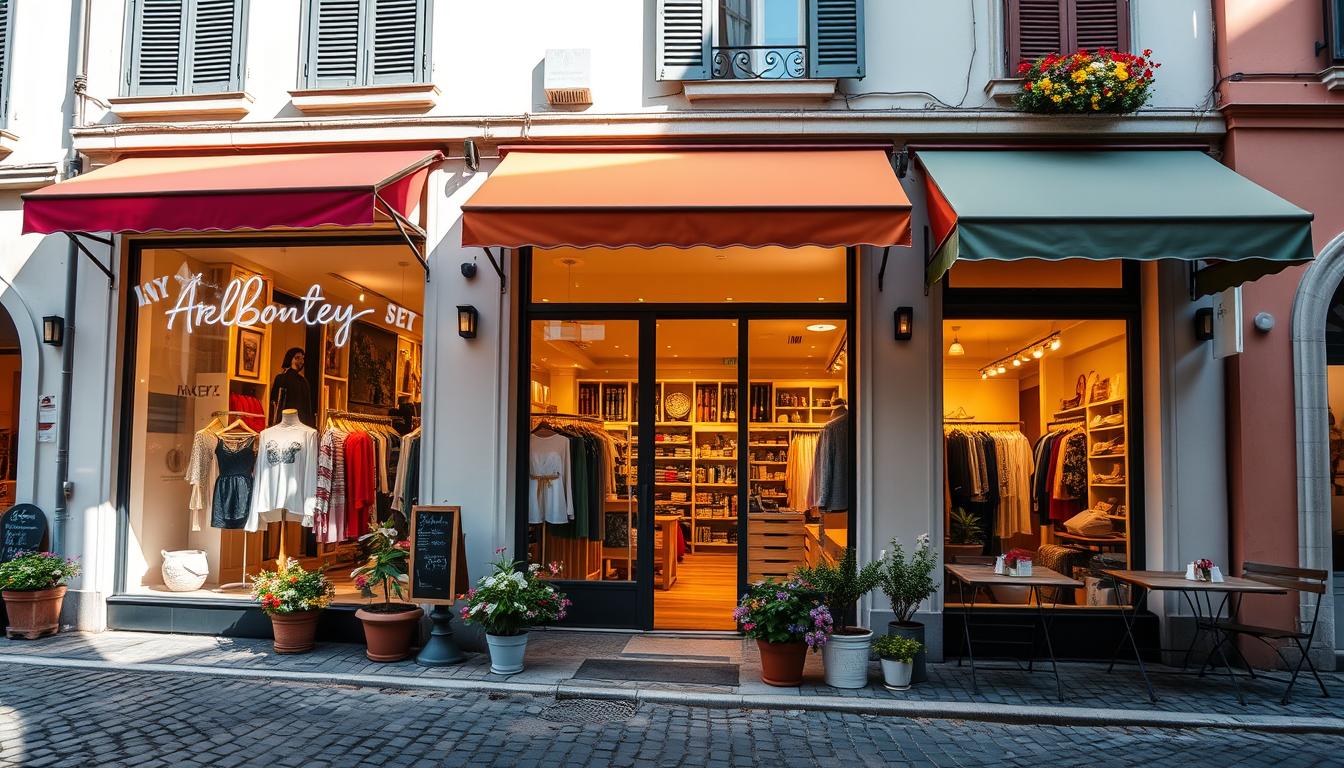“Fashion is the armour to survive the reality of everyday life.” – Bill Cunningham. Starting a boutique in Italy is like stepping into a world of rich culture and creativity. Italy is famous for its fashion and culture, making it perfect for entrepreneurs. We’ll look at what it takes to succeed in this beautiful country.
Italy’s fashion is more than just shopping; it’s an art form. Opening a boutique here means diving into a world that values uniqueness and skill. We’ll cover everything from market trends to legal needs, helping you succeed in Italy’s boutique scene.
The Allure of Starting a Boutique in Italy
Starting a boutique in Italy is truly captivating. The heart of Italian fashion is filled with creativity and tradition. Cities like Milan and Florence are where old meets new, making Italy a top spot for boutique owners.
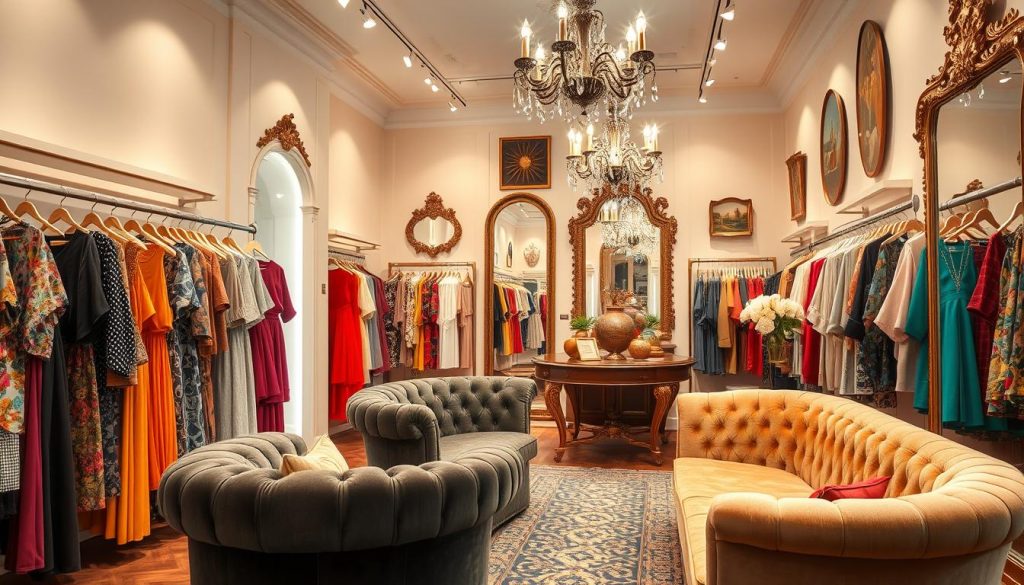
Italian fashion is famous worldwide, with top brands leading the way in style. This lively scene offers chances to create special shopping experiences for many people.
- Craftsmanship: The focus on quality craftsmanship attracts those who value authentic fashion.
- Tourism: The many international visitors mean a steady flow of potential customers for our boutiques.
- Cultural Heritage: Using Italy’s rich history helps us tell stories that make our brand more appealing.
Starting a business in Italy has its ups and downs. The financial setup is clear, with laws for different business types. You can choose from a Limited Liability Company (SRL) or a Sole Proprietorship, depending on your needs.
As we dive into this exciting field, connecting with local artisans and understanding Italian fashion is key. This dedication not only grows our business but also makes our boutique stand out in the fashion world.
Understanding the Italian Market Landscape
The Italian market is full of chances in the fashion world. It has its own ways of shopping and new trends in boutiques. For those starting businesses, knowing this world well is key.
What people like to buy is very important here. Italians often choose quality over having lots of things. They love things made well and being true to their brand.
Studies show that more people are buying sustainable and second-hand clothes. In 2023, 60% of Italians bought used items. This shows they really like the idea of circular fashion.
Prices are also a big deal because of inflation. More people are going to discount stores and buying private labels. Boutiques need to think about prices to keep customers coming back.
Digital tech is also changing things. Stores can now offer unique shopping experiences. They use AI and immersive tech to make shopping memorable and fun.
Looking at what others are doing is also important. It helps us see what we might face and what chances we have. Knowing about foot traffic, who lives nearby, and how people shop helps us pick the best spot for our boutique.
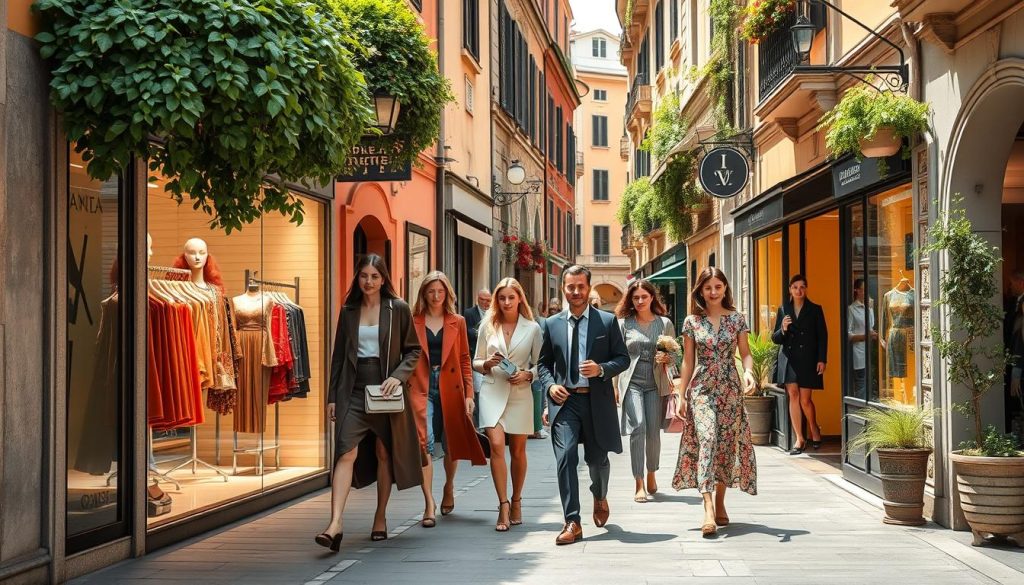
Cost of Living Considerations When Opening a Boutique
Knowing the cost of living in Italy is key for starting a boutique. Prices differ a lot between cities like Milan and Rome and rural areas. In cities, rent and utilities are high, taking up a big part of our budget. But, rural spots might be cheaper, yet they often have less foot traffic.
When setting up our boutique, we must think about these costs in our budget. For example, hiring a consulting firm for a business plan could cost between $1,000 and $5,000. This could be worth it to understand the market better. Also, market research helps us learn about our customers and local trends.
Starting our business needs careful money planning. We can get money through equity or debt. SBA loans have payments we must plan for. The IRS lets us write off up to $10,000 in startup costs, if we don’t spend more than $60,000. It’s important to get these numbers right, as 78% of small business owners see rising costs as a big risk.
With inflation and higher energy costs, we might need to raise our prices to stay profitable. Finding the right balance between price and cost is tough. We need to be ready to adjust our plans as living costs change.
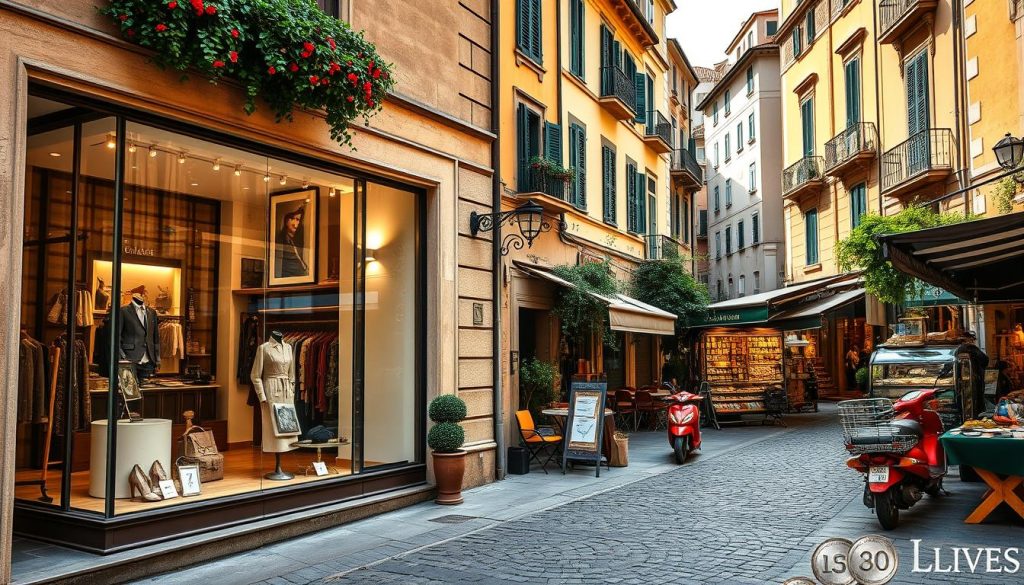
Key Factors Influencing the Italian Economy
The Italian economy is shaped by many factors. Tourism is a big help, making Italy a top tourist spot. This brings in lots of visitors, creating chances for the retail and boutique sectors.
But, Italy’s GDP per capita has dropped, making it less competitive. Since 1999, productivity has also fallen. Italy spends only 1.5% on research and development, less than Germany and Sweden.
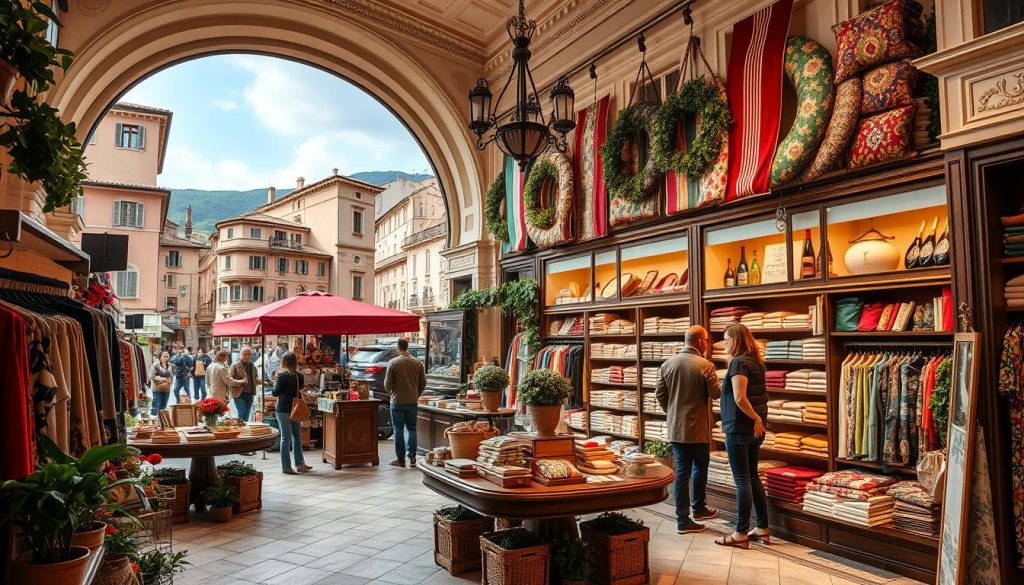
Italy’s ageing population is another challenge. It has low birth rates and an ageing population, making growth hard. Italy also spends a lot on pensions, which adds to the economic strain.
Despite these issues, Italy’s GDP has grown. In 2023, it reached USD 2,302 billion. Private spending made up 58% of GDP in 2021, showing strong demand for our products.
Italy’s main trading partners are key to its economic stability. We need to adjust our strategies in the boutique industry to meet these challenges. Understanding these factors helps us thrive in this dynamic market.
Tax Implications for Your Boutique in Italy
Understanding the Italian tax system is key for our boutique’s success. We face various business taxes that affect our profits. These include personal income tax, corporate income tax (IRES), and the regional production tax (IRAP).
Value-added tax (VAT) is a major tax we need to handle. Italy’s standard VAT rate is 22%. But, there are lower rates for some items like food and drinks, and for products related to children. VAT can be waived in some cases, like for sales within the EU or exports.

For online sales across borders, VAT rules get tricky. If we sell over €10,000 to other EU countries, we must charge VAT based on the buyer’s location. This rule also applies to digital content sales, after hitting the €10,000 sales mark.
- VAT refunds are possible for non-EU residents for EU purchases, if customs validate them.
- Not checking the validity of export declarations can lead to penalties.
- Since 1 January 2019, we must use electronic invoicing.
- Our VAT return filing deadline is 30 April each year.
It’s vital to stay informed about these tax rules for better financial planning. Following these regulations helps us avoid fines and take advantage of tax breaks for new businesses.
Choosing the Right Location for Your Boutique
Finding the perfect spot for your boutique is key to success. We need to look at both city and countryside locations. Each has its own benefits and drawbacks, especially when it comes to foot traffic and rent.
By knowing these differences, we can pick a location that fits our business goals. This helps us succeed in the competitive retail world.
Exploring Urban vs. Rural Opportunities
City spots usually have lots of people walking by, which means more chances to be seen and remembered. Clothes shops do well here because people often go shopping.
But, countryside areas might have cheaper rents and a special charm. They attract a different crowd. So, it’s all about who we want to sell to.
Understanding Local Customer Preferences
What people like to buy changes a lot depending on where they live. Richer areas might want high-end clothes, while places near schools or fun spots are good for younger shoppers.
We also need to watch what our competitors are doing. Knowing what locals like to buy helps us pick the right items and market them well.
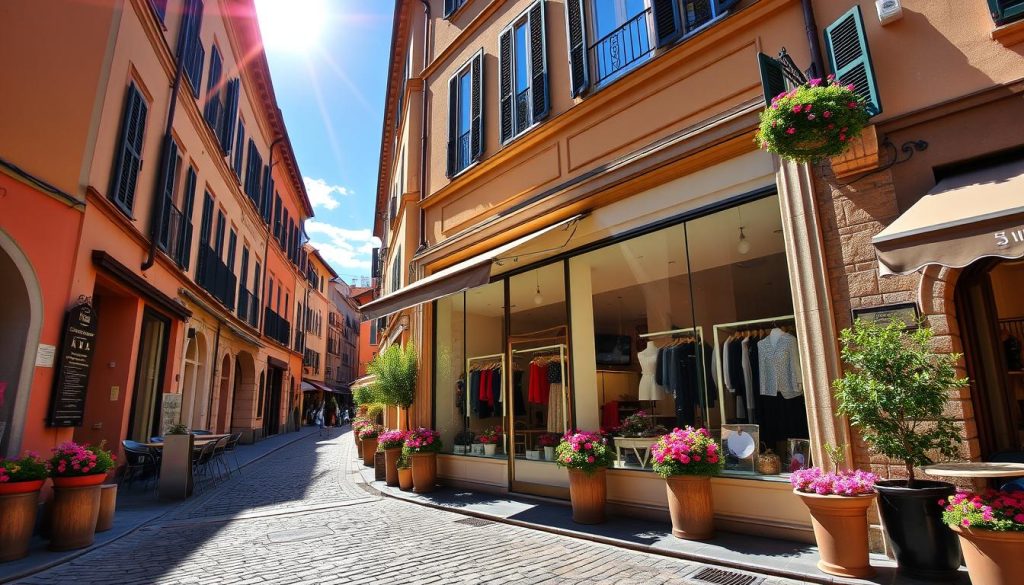
Legal Requirements for Starting a Boutique in Italy
Starting a boutique in Italy means following a set of legal steps. These steps help us meet the boutique laws. We must first register our business with the Italian Business Register. This step is key to making our venture official.
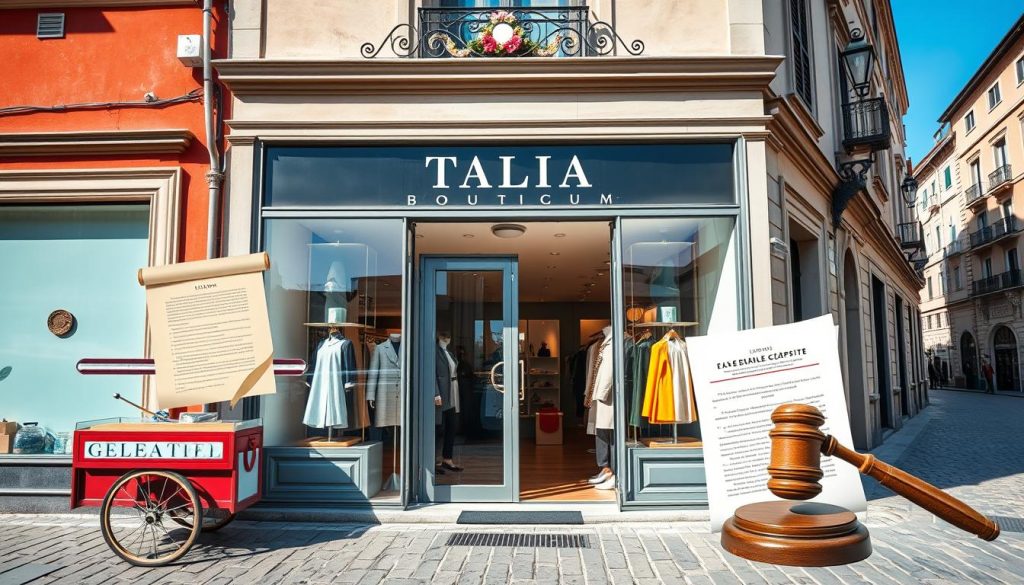
Getting the right permits is also vital. For example, we need a SCIA (Segnalazione Certificata di Inizio Attività) to start. We must also know the employment laws well. This ensures we follow rules about hiring and treating employees right.
Knowing health and safety laws is not just a rule. It’s also important for keeping our boutique safe for everyone.
Starting up comes with costs. Hiring an accountant can help with these costs. When making our business plan, we should include a budget. This way, we can cover all the legal and operational costs and open our boutique smoothly.
In short, knowing the legal steps is crucial for starting a boutique in Italy. By carefully following the business registration and laws, we build a strong base for our business.
Business Structure Options for Your Boutique
Starting a boutique in Italy is exciting. The business structure you choose affects how you operate, your taxes, and legal risks. You have two main options: being a sole trader or a limited company. Each has its own benefits and drawbacks.
Understanding Sole Trader vs. Limited Company
Being a sole trader is simple and gives you full control. It doesn’t need special filings, which is great for beginners. But, it doesn’t protect your personal stuff well, so you could lose your assets if the business fails.
On the other hand, a limited company, or SRL in Italy, protects your personal assets. It’s more complex, needing legal filings and following rules. But, it can attract more money and make customers trust you more.
Choosing the right business structure is key in Italy’s $32 billion clothing market. Building strong local ties can boost sales. Good marketing can also make your brand well-known.
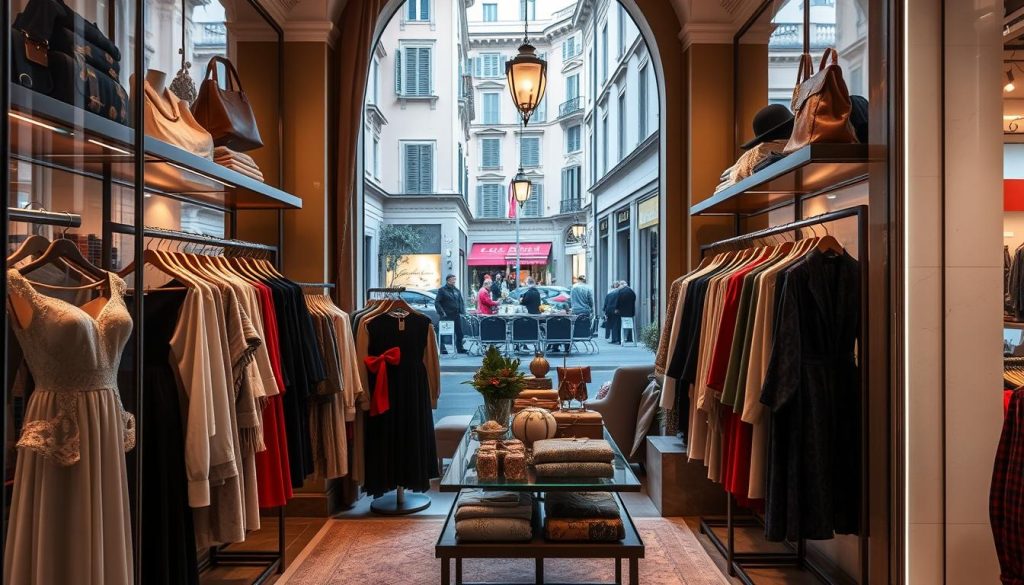
Navigating the Visa Process for Entrepreneurs
Starting a business in Italy as a non-EU entrepreneur means knowing your visa options. There are different visas for entrepreneurs, like the self-employment visa and startup visa. These are made for international business ventures.
The self-employment visa lets you run your business in Italy. You need a good business plan and experience. The startup visa is for new, innovative projects. It needs approval from an incubator or business angel, making the process easier.
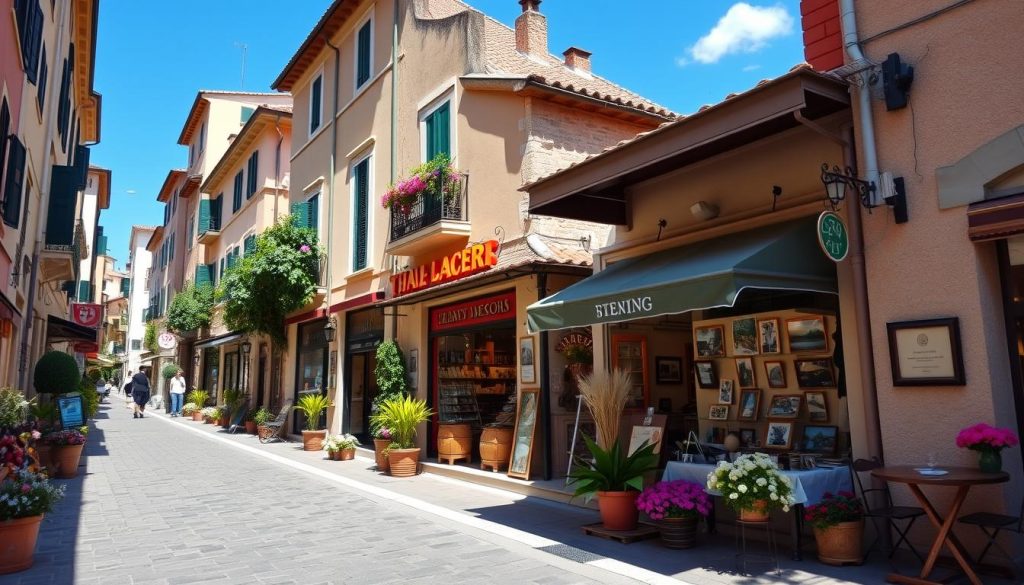
Getting a visa can take weeks. It’s important to have all your documents ready. This avoids delays. Start by making a strong business plan and having your finances in order.
It’s key to know what the visa needs. You’ll need to show you can support yourself financially. Knowing this can help make the visa process smoother for entrepreneurs in Italy.
Crafting a Comprehensive Business Plan
A well-made business plan is like a roadmap for our boutique. It shows our goals and how to reach them. This plan helps avoid mistakes and attracts investors. It also helps us know our strengths and weaknesses.
It gives us a plan for growing in the future.
Identifying Your Target Audience
Finding out who our customers are is key. We do this by studying market trends and what people want. This helps us make things that our customers will love.
By understanding our audience, we can make our products better. This makes customers more likely to buy from us.
Setting Financial Projections and Goals
Our financial plan is very important. It shows what we expect to earn and spend over time. This plan helps us make smart financial choices.
We have short-term goals for now and long-term goals for the future. Investors want to see these plans to know if we’re doing well. With good forecasts, we can plan our budget and look for funding.
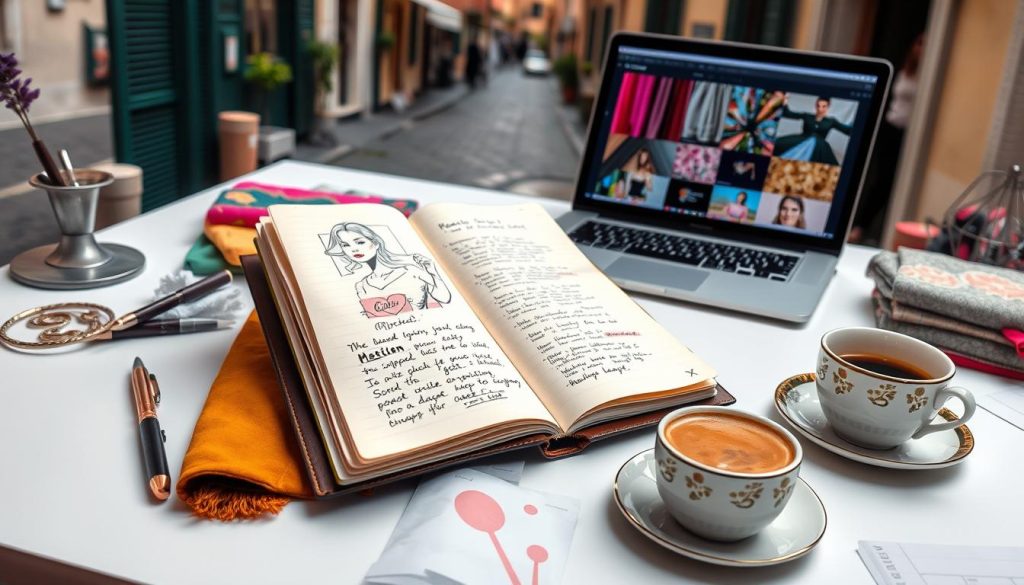
Funding Your Boutique Venture
Starting a boutique in Italy needs careful thought about funding. Personal savings or investments are good ways to get financial support. We can also look at business funding from banks, which usually have a 12-month term.
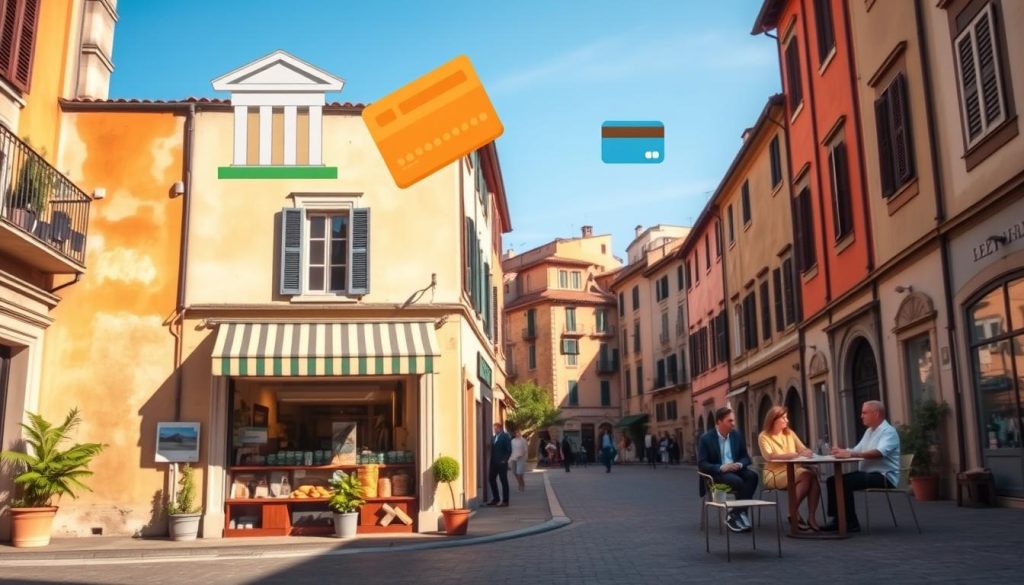
Government grants are another option for small businesses. There are hundreds of grants out there, focusing on job creation and boosting the economy. Equity finance schemes offer tax cuts, making them attractive for new businesses.
- The Start-Up Loans scheme gives personal loans up to £25,000 at 6% interest. It comes with business support and mentoring.
- Venture capitalists and angel investors can also help, offering £50,000 to hundreds of thousands of pounds.
- Purchase order finance helps with cash flow, benefiting startups and small businesses.
A strong business plan is key. It draws in investors and shows our boutique idea works. Networking at events also helps find the right funding. A clear pitch with realistic financial plans will win over investors, ensuring our venture grows well.
Designing an Appealing Boutique Concept
Creating a welcoming boutique design is key to engaging customers and showing our brand’s identity. Good visual merchandising does more than just show our products. It turns our shop into an experience. Think about these important points when designing our boutique.
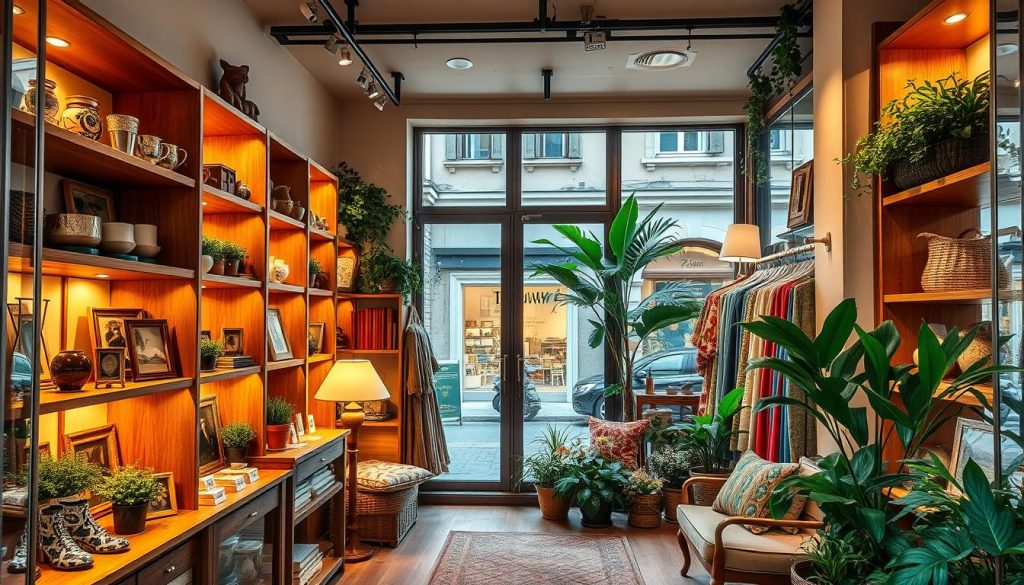
First impressions are everything. Up to 90% of customers judge a store by its colour in just 90 seconds. So, picking a colour scheme that works well together is vital. Lighting also plays a big role in the shopping experience.
Soft lighting makes the atmosphere feel more positive. Natural light not only cuts down on energy use but also boosts the mood of our space. Using lighting smartly can draw attention to important products and change how customers act.
- Use mirrors to make the space feel bigger.
- Design fitting rooms with lights that face the front for a better experience.
- Add comfy seating areas to get customers to stay longer.
- Include indoor plants to make the space look better and improve air quality.
The first 5 to 15 square feet, or the decompression zone, are very important. A clean and open layout can make the shopping experience better and make products seem more valuable. It’s good to plan a clear path for customers to follow, encouraging them to explore and make choices.
Having a consistent theme and visual identity across all areas helps our brand. This can be done with custom signs and seasonal displays that grab attention. Adding interactive and sensory elements can make shopping more fun, turning window shoppers into loyal customers.
Creating a friendly and welcoming atmosphere helps keep customers coming back. In fact, 84% of shoppers are more likely to return to boutiques that feel welcoming. By carefully considering these design principles, we can make a boutique that attracts customers and showcases our unique shop concept.
Effective Marketing Strategies for Your Boutique
Starting our boutique means we must focus on marketing. The fashion online market is set to hit $1.2 trillion by 2027. This is a big chance for us to stand out.
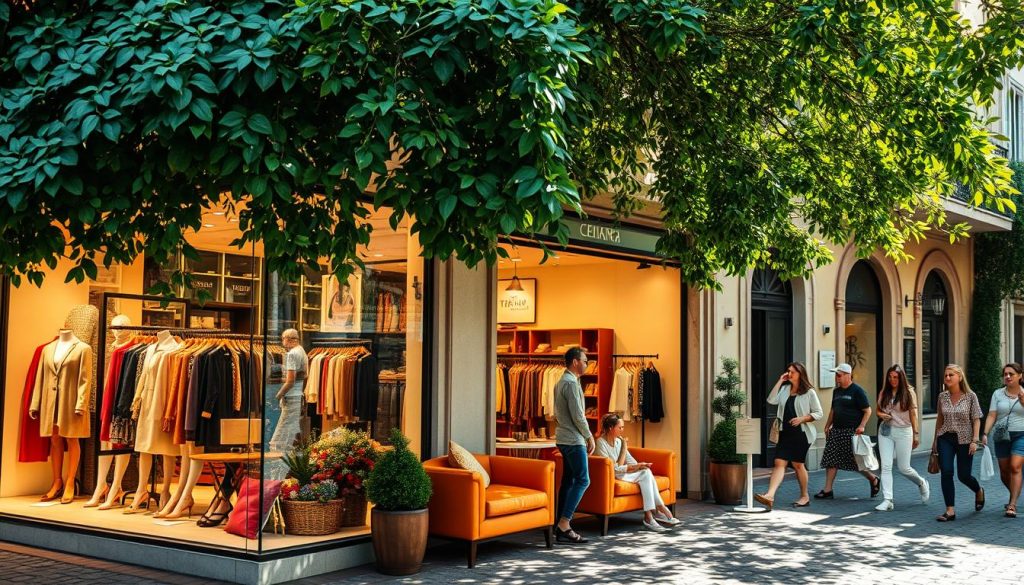
Using social media is key today. Sites like Facebook, Instagram, and TikTok help us talk directly to our audience. With billions of users, our message can reach far.
Working with influencers is also smart. Fashion bloggers and vloggers can help us sell more and get noticed. This boosts our brand and sales.
Knowing how to market in retail is important. A good online plan, like live shopping on Instagram, can really engage customers. Making our site easy to use on phones is a must, as more people shop on mobiles.
Building a brand community is valuable. Facebook Groups can be a place for our customers to talk and feel part of something. This helps keep them loyal to us.
Using a system like Rain POS helps us keep our stock in check. This means customers can find what they want online or in-store. Good money management is key, with plans tailored to our customers and careful stock watching.
Understanding what our customers like helps us offer better deals. Even with some stores closing, the right marketing can help us thrive. We can make our boutique a success.
Building Strong Relationships with Suppliers
Building strong relationships with suppliers is key to our boutique’s success. We need to find reliable Italian and international suppliers. They should offer high-quality products and meet our needs.
Good communication and teamwork help build trust. This ensures products arrive on time, making our operations smooth.
Finding Reliable Italian and International Suppliers
In today’s world, companies often rely on suppliers for many things. Small businesses like ours need strong agreements with suppliers. These agreements help avoid misunderstandings and set clear expectations.
Important parts of a supplier agreement include:
- Outlining expectations, responsibilities, and deliverables
- Pricing structures, discounts, and payment terms
- Quality guidelines and testing procedures
- Legal protections, such as dispute resolution mechanisms
- Continuous improvement and innovation clauses
Working with suppliers long-term can lead to better prices and terms. This helps us control costs and increase profits. Trade shows are great for meeting suppliers and building relationships.
Meeting suppliers in person at trade shows strengthens our bonds. It also keeps us updated on the latest fashion trends and technologies.
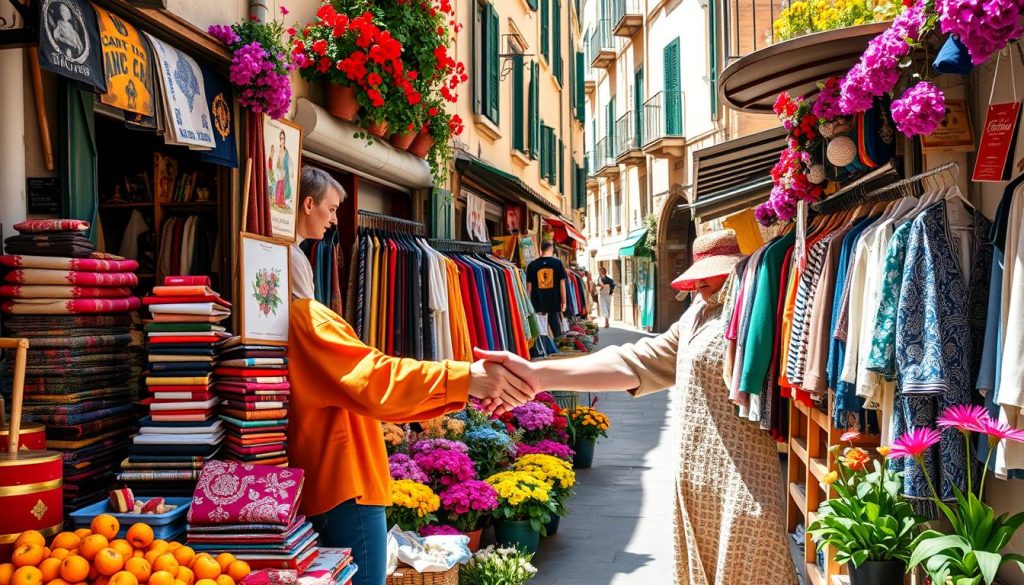
Hiring Staff for Your Boutique
Getting the right staff is key to a successful boutique in Italy. The first step is to write a clear job description. This can boost the quality of applicants by about 30%.
It’s important to post jobs on various platforms. Using only our website might not reach enough people. Indeed and Craigslist can increase applicants by 50%. With over 200 million CVs on Indeed, we can find great candidates.
Using assessment tools in hiring can cut turnover by nearly 40% in retail. This helps us find the right fit for our boutique’s culture.
Offering good pay and benefits is crucial for attracting top talent. Paying competitively can increase interest by up to 45%. Retail sales jobs pay between $10 and $22 an hour. Roles like visual merchandisers or buyers can also add value, with salaries from $44k to $170k.
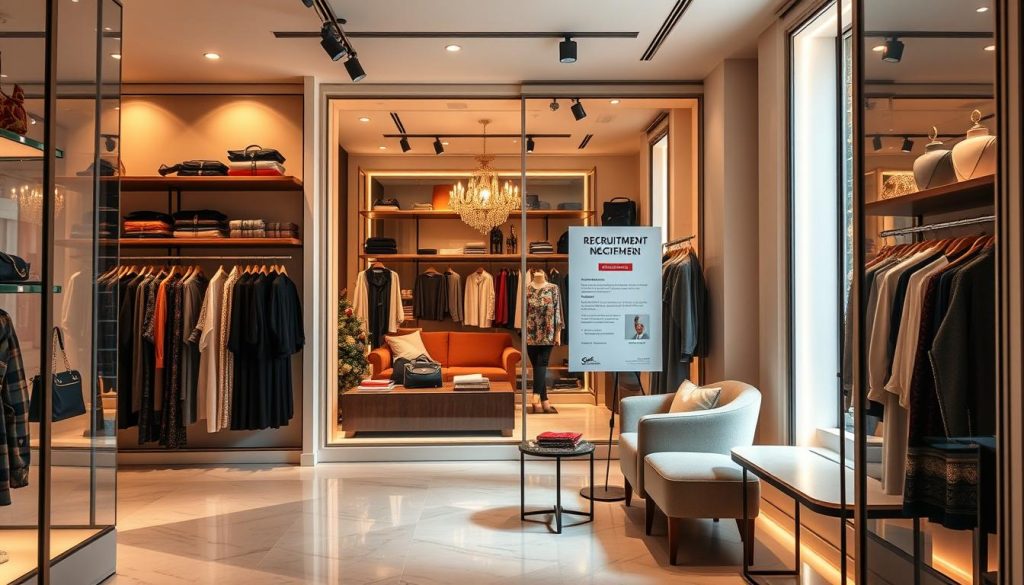
Good employee management is key to long-term success. A strong onboarding process can make employees 60% happier and more likely to stay. This builds a positive work culture, which improves customer service.
By focusing on clear job roles, diverse recruitment, and good onboarding, we can improve staff performance. This approach helps our boutique grow and succeed.
Emphasising the Importance of Brand Identity
In the world of boutique branding, having a strong brand identity is key to success. It helps us stand out from the crowd and connect with our audience. This connection is crucial for defining what makes us special in a busy market.
Our brand identity includes many parts that work together. Things like logos, colours, and fonts help make our brand memorable. For example, colours can make people feel certain ways, so we choose them carefully to match our audience.
Words like our brand name and tagline also play a big role. They share our values and tell our story. How we interact with customers and the design of our packaging also shape what people think of us. All these things help build our brand image.
Being true to ourselves is vital when building our brand. Today’s shoppers want to trust the brands they support. Research shows that 71% of Gen Z shoppers prefer to deal with brands they trust. This means we need to know our audience well and offer them experiences that make them loyal.
By focusing on our brand identity, we set a clear direction for how people see us. This connection between our identity and image helps us stay relevant as the market changes. With more mergers and rebranding expected in 2024, a strong brand identity will be more important than ever.
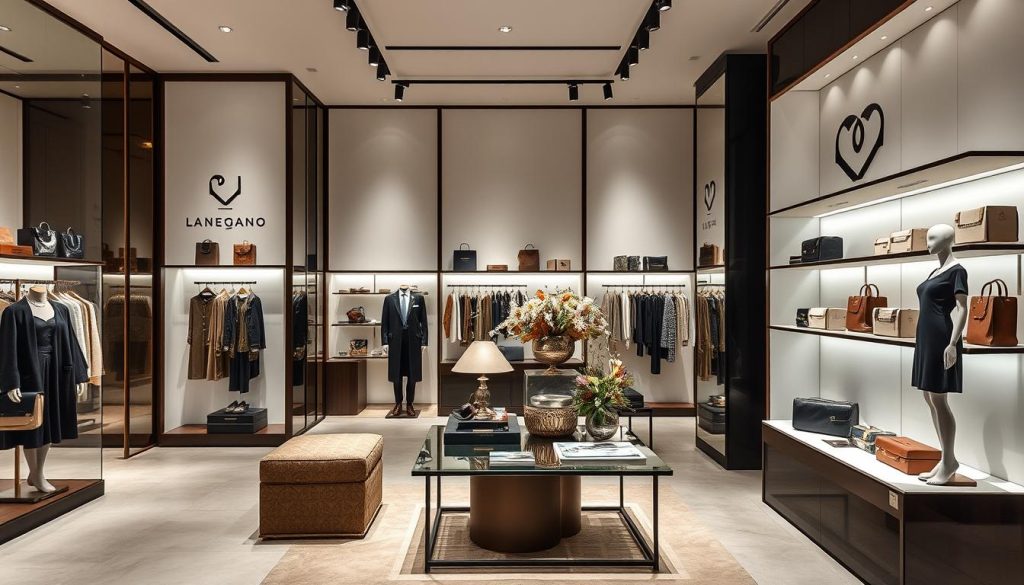
Customer Experience: Making Your Boutique Stand Out
In the world of boutique retail, giving customers a great experience is key. We focus on making in-store visits special. This includes personal styling and helping customers declutter their closets.
Did you know that 68% of boutique owners in Italy offer personal styling? It has boosted their sales by 25%.
We think making shopping unique is good for more than just sales. It builds loyalty. Customers who get a personal shopping experience are 40% more likely to come back. They also show a 50% higher loyalty rate.
Hosting special events, like after-hours styling sessions, can really help. They can increase foot traffic by 30%. Sales might go up by 15% in the next week too.
Training staff is crucial for a top-notch customer experience. Almost 82% of boutique owners invest in staff training. They see it as a way to improve and even get tax benefits.
By listening to customer feedback and always looking to improve, we grow. This approach boosts our social media presence and word-of-mouth. It’s vital for our brand’s success in today’s market.

